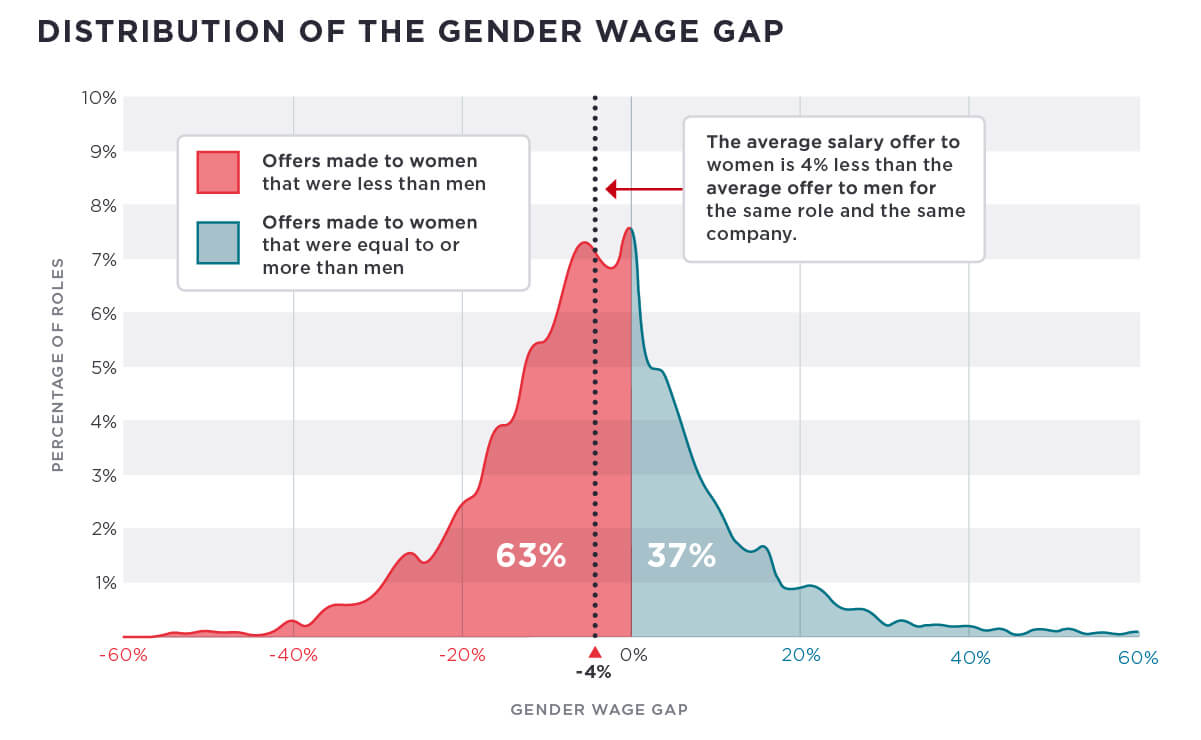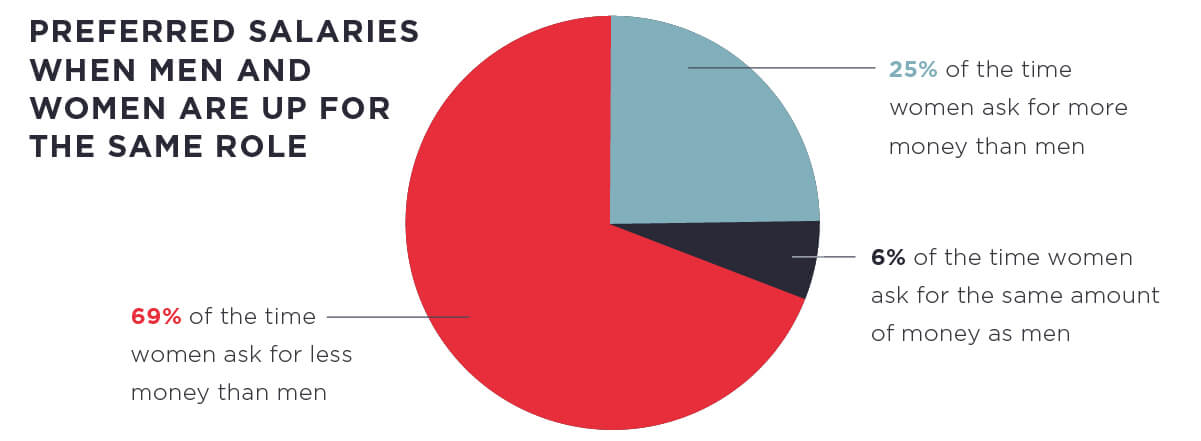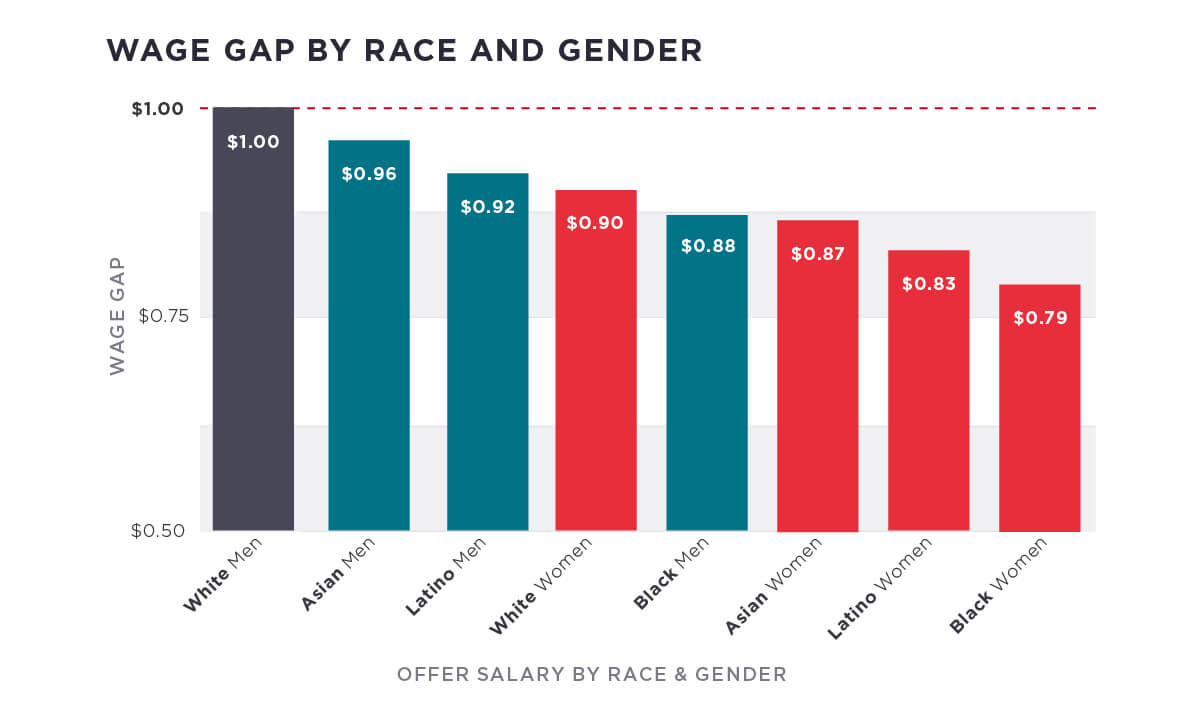2017
Women, Work, and
the state of
Wage Inequality
Overview
In many ways, women’s issues have taken center stage over the last year. Hillary Clinton became the first woman to be nominated by a major American political party as its candidate for President. Millions of people around the world participated in “A Day Without A Woman,” and the Women’s March in Washington D.C. became the largest single-day demonstration in recorded U.S history. The U.S. Treasury announced that women’s and civil rights leaders like Harriet Tubman, Sojourner Truth, and Susan B. Anthony would be added to newly redesigned U.S. currency. And while one could argue that awareness of women’s issues and engagement are at an all-time high, gender equality metrics haven’t budged in recent years. Just 5% of Fortune 500 companies have a female CEO and only 20% of Congress is female. The wage gap is closing so slowly that men and women aren’t expected to reach pay equality until 2152. At Hired, we’re particularly passionate about this last issue, so in honor of Equal Pay Day 2017, and for the second year in a row, we’ve analyzed our massive data set to better understand how the wage gap looks in the tech industry. This year we’re excited to take our analysis a step further by looking at how race and LGBTQ status intersect with gender to impact salaries and salary expectations. By providing insights about wage inequality in the workplace, we aim to empower companies and candidates alike to close the gap. We encourage companies to use this data and investigate their own compensation policies to ensure that they are not perpetuating patterns of inequality. And for candidates, we want to arm them with the objective information they need to ask for a salary in line with their market value. This issue certainly won’t be solved overnight, but with both sides working together, we’ll be on a path towards closing the gap and making inequity in the workplace a thing of the past.
Same Job, Same Company: Women Receive Less
Our data shows that 63% of the time women receive lower salary offers than men for the same job at the same company. This figure has improved slightly from 69% since our 2016 report. On average, women are offered 4% less than male applicants for the same role, with some companies offering women up to 50% less. In fact, for one out of every ten job openings we analyzed, companies offered men salaries that were at least 20% higher than those offered to women. This pay gap is likely the result of a number of factors. These might include unconscious bias during the interview process, and compensation policies that determine a candidate’s salary based on what he or she was previously making, rather than the market rate for that individual’s skills and years of experience. Notably, the effects of gender bias affect access to opportunity as well. We found that 53% of the time, companies interviewed only male candidates for a given role, whereas the reverse was true just 6% of the time. Even when controlling for the fact that our candidate pool skews more male, we still found that women were underrepresented in the interview pool two-thirds of the time. Long term, these kinds of biases during the hiring process may contribute to the gender disparity we see in the tech industry, like the fact that women are twice as likely as men to leave the space.
The Expectation Gap Contributes to Pay Inequality
When examining our candidates’ preferred salaries, we discovered that for 69% of the roles for which both a man and a woman were given an initial offer, women set their preferred salary less than men. Women asked for an average of 4% less than men, though this number rose to as much as 80% in some cases. These numbers follow closely to the wage gap data reported in the previous section of this report, revealing a clear connection between the salaries candidates ask for and the salaries that they are offered. At Hired, we find that 59% of the time, individuals on our platform receive their preferred salary, demonstrating just how important it is for a candidate to know and ask for what they’re worth. To better understand how negotiation impacts the gender wage gap, we also compared initial salary offers, which are made at the beginning of the interview process, with final salary offers, which are made after all interviews and salary negotiations are complete. In looking at final salary offers, we found that the gender wage gap increases from 4% to 5%. This underscores the negative impact that negotiation has on the gender wage gap and findings from various studies show that even when women do negotiate, they are less likely than men to be successful.
Early in their careers, women ask for more money than men
When we segment women by years of experience before analyzing their salary preferences, the results paint a more positive picture. Female candidates with four years of work experience or less actually ask for more money than their male counterparts—and they get it. Looking specifically at women with less than one year of experience, we see that they ask for an average of 4% more money than men, and are ultimately offered an average of 8% more. This means that for every dollar a man with less than one year of experience makes, his female counterpart makes $1.08. The fact that women are asking for more money earlier in their careers may be a result of the attention given to the gender wage gap in recent years, the increasing number of resources available to find objective salary information, or some other factors. Unfortunately, the wage gap appears when we look at candidates with more than six years of experience, which may be around the time when they start having children. Research shows that women’s salaries are likely to decrease after they have children, while men experience the opposite effect. This may also be the time at which the effects of being paid slightly less than men or being less able to negotiate start to appear, which ultimately starts a cycle that compounds over time and results in a much wider gap down the road.
White Men Outearn Everyone Else
In our recent State of Salaries report, we examined how race impacts salary and salary expectations. For this report, we wanted to take this one step further to understand how the combination of race and gender impact compensation. The results are not encouraging. What we found is that on average, white men are offered the highest salaries and black women are offered the lowest salaries. In fact, black women earn 79 cents on the dollar to white men, which is twice as large as the gap between white men and white women. Overall, males of all races receive higher salary offers than women with one exception: white women are offered two percent more than black men.
It is important to note that we did not have a large enough sample size for black and Latino candidates to break this group down by both race and gender. To produce the chart above we combined the overall race gap and the overall gender gap. We found that this method accurately predicted the gender wage gap for white and Asian women (where we had large enough sample sizes). That said, it’s possible that for black and Latino candidates, the combined effects of being a racial minority and a woman are greater than simply the combination of these two gaps.
LGBTQ Candidates Earn Less
In addition to looking at how race intersects with gender to impact compensation, we also wanted to understand the effect that LGBTQ (Lesbian, Gay, Bisexual, Transgender and Queer) status has on salary. What we found is that non-LGBTQ men outearn all other categories, followed by LGBTQ men, non-LGBTQ women and finally, LGBTQ women. Salary expectations followed the same pattern.
Conclusion
There are a few important conclusions from this report. The first is that even when controlling for the large percentage of men in the tech industry—and thus our candidate base—women remain vastly underrepresented in the interview pool. Combine this with the fact that women are offered less money for the same role at the same company 63% of the time and it confirms a stark and sobering truth: women face a one-two punch of bias and wage inequality. They struggle to make it into the consideration set at the same rate as men, and even when they do, they are being paid less than their male peers. While unequal treatment of women in the workplace is not a new issue—and has, in fact, received more attention as a result of recent, highly publicized events in the tech industry—it’s a disturbing trend nonetheless. The extent of this problem is underscored when you consider this is happening to women whose skills are in extremely short supply and who work in an industry lauded as forward-thinking on social issues. At Hired, we take a long-term view on these issues. While we’re frustrated that some of the key figures in this report have only improved slightly since we first looked at the data a year ago, we know that things like diversity and gender inequality simply can’t be solved overnight, nor can they be adequately understood through numbers and charts alone. We hope this report can be a starting point for larger discussions, and a call to action for everyone involved. These are hard problems without easy answers, but measurement and acknowledgment are first steps. Through reports like these, awareness campaigns and product features that aim to reduce bias and educate all candidates and companies, we remain committed to highlighting, quantifying, and speaking out about this issue. We hope you’ll join us.
Methodology
This report is based on proprietary data gathered and analyzed by Hired’s research and strategy data scientist, Dr. Jessica Kirkpatrick. The analysis in this study was done using a combination of voluntary, self-reported demographic data and a classifier that identified the gender of the candidate based on their first name. Kirkpatrick also cross-referenced the results of the name classifier with the pronouns used in the letters of recommendation submitted by candidates through the Hired platform. Only data from candidates with unambiguous gender classifications were used in this report. Data related to race and LGBTQ status was collected through an optional, self-reported demographics survey given to Hired candidates that is used only for aggregated research purposes and not shared with Hired clients. The salaries included reflect base pay only and are drawn from a sample set of more than 120,000 interview requests and job offers from the past year facilitated through our total marketplace of 8,000 participating companies and more than a million job seekers.
About Hired
At Hired, we believe that fast-growing businesses need a better way to cut through the noise and find the talent who will help them fulfill their missions. We believe that top tech talent should have opportunities brought to their doorstep so that they can find the one that aligns with their lifestyle and will enable them do their best work. We’ve built a career matching platform that intelligently connects outstanding technology workers with the world's most innovative companies. By taking the pain out of the job search, we want to empower everyone to find and do their best work, from one opportunity to the next. Hired is headquartered in San Francisco, with offices in cities across North America and Europe. For more information, news, and tips for candidates and employers, visit Hired’s blog.





